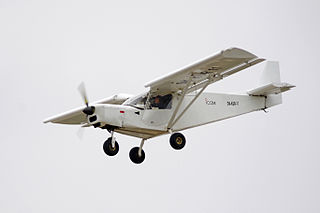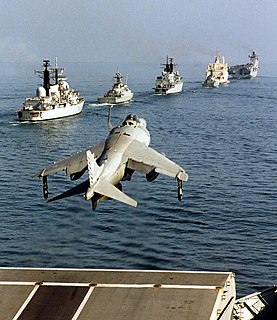
A short take-off and vertical landing aircraft is a fixed-wing aircraft that is able to take off from a short runway and land vertically. The formal NATO definition is:
A Short Take-Off and Vertical Landing aircraft is a fixed-wing aircraft capable of clearing a 15 m obstacle within 450 m of commencing take-off run, and capable of landing vertically.

Takeoff is the phase of flight in which an aerospace vehicle goes from the ground to flying in the air.

A vertical and/or short take-off and landing (V/STOL) aircraft is an airplane able to take-off or land vertically or on short runways. Vertical takeoff and landing (VTOL) aircraft are a subset of V/STOL craft that do not require runways at all. Generally, a V/STOL aircraft needs to be able to hover. Helicopters are not considered under the V/STOL classification as the classification is only used for airplanes, aircraft that achieve lift (force) in forward flight by planing the air, thereby achieving speed and fuel efficiency that is typically greater than the capability of helicopters.

The flight deck of an aircraft carrier is the surface from which its aircraft take off and land, essentially a miniature airfield at sea. On smaller naval ships which do not have aviation as a primary mission, the landing area for helicopters and other VTOL aircraft is also referred to as the flight deck. The official U.S. Navy term for these vessels is "air-capable ships".

The Yakovlev Yak-38 was the Soviet Naval Aviation's only operational VTOL strike fighter aircraft in addition to being its first operational carrier-based fixed-wing aircraft. It was developed specifically for, and served almost exclusively on, the Kiev-class aircraft carriers.

A tail-sitter or tailsitter is a type of VTOL aircraft that takes off and lands on its tail, then tilts horizontally for forward flight.

The Bell X-14 is an experimental VTOL aircraft flown in the United States in the 1950s. The main objective of the project was to demonstrate vectored thrust horizontal and vertical takeoff, hover, transition to forward flight, and vertical landing.

The Convair XFY Pogo was an experiment in vertical takeoff and landing (VTOL) tail-sitter. The Pogo had delta wings and three-bladed contra-rotating propellers powered by a turboprop engine. It was intended to be a high-performance fighter aircraft capable of operating from small warships. Landing the XFY-1 was difficult, as the pilot had to look over his shoulder while carefully working the throttle to land.
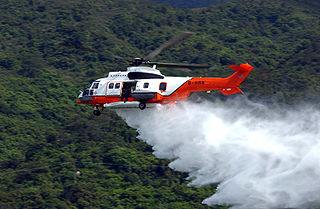
A rotorcraft or rotary-wing aircraft is a heavier-than-air flying machine that uses lift generated by wings, called rotary wings or rotor blades, that revolve around a mast. Several rotor blades mounted on a single mast are referred to as a rotor. The International Civil Aviation Organization (ICAO) defines a rotorcraft as "supported in flight by the reactions of the air on one or more rotors". Rotorcraft generally include those aircraft where one or more rotors are required to provide lift throughout the entire flight, such as helicopters, autogyros, and gyrodynes. Compound rotorcraft may also include additional thrust engines or propellers and static lifting surfaces.

Powered lift or powered-lift refers to a type of aircraft that can take off and land vertically and functions differently from a rotorcraft in horizontal flight.
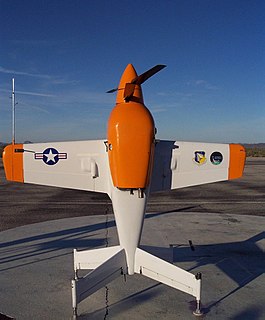
The SkyTote is an unmanned aerial vehicle (UAV), tail-sitter Vertical Take-Off and Landing (VTOL)-fixed wing hybrid plane, which attains the advantages of both airplane designs. In order to control the vehicle when transitioning between vertical take-off to forward flight, an adaptive neural network controller was designed by Guided Systems Technologies and used on the vehicle. The vehicle was developed by AeroVironment, under a contract given by the Air Force Research Laboratory, and its primary purpose is cargo-delivery.

The Saab Skeldar is a medium-range VTOL UAV developed by the Swedish aerospace company Saab. Missions for the Skeldar involves surveillance, intelligence gathering, light cargo transportation and electronic warfare.

The Israel Aerospace Industries Panther is a tilt-rotor unmanned aerial vehicle (UAV) produced by Israel Aircraft Industries in Israel.
Aircraft can have different ways to take off and land. Conventional airplanes accelerate along the ground until sufficient lift is generated for takeoff, and reverse the process to land. Some airplanes can take off at low speed, this being a short takeoff. Some aircraft such as helicopters and Harrier Jump Jets can take off and land vertically. Rockets also usually take off vertically, but some designs can land horizontally.
ZIA UAV is a Chinese experimental UAV developed by Zhengzhou Institute Of Aeronautical Industry Management, and it is a VTOL UAV. The complete name for this Chinese experimental UAV is called Shape Varying VTOL UAV.
NWPU V/STOL UAVs are Chinese V/STOL UAVs developed by Northwestern Polytechnical University (NWPU). Most of these are proof of concept experimental UAVs to explore new technology in the arena of V/STOL.

The Xplorair is a project of compact VTOL aircraft without rotating airfoil from aerospace engineer Michel Aguilar, funded by the French Armed Forces procurement agency DGA and supported by various European aeronautics firms such as Dassault Systèmes, EADS Innovation Works, MBDA, Altran Technologies, Sogeti, Turbomeca, COMAT Aerospace and the Institut Pprime. Announced in 2007, the project aimed to develop a UAV prototype scheduled for flight in 2017, followed by a single-seater flying car whose commercialization could occur the decade after.
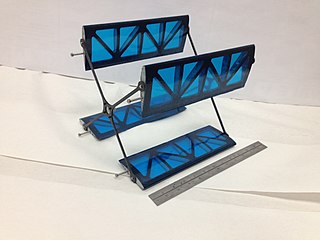
A cyclorotor, cycloidal rotor, cycloidal propeller or cyclogiro, is a fluid propulsion device that converts shaft power into the acceleration of a fluid using a rotating axis perpendicular to the direction of fluid motion. It uses several blades with a spanwise axis parallel to the axis of rotation and perpendicular to the direction of fluid motion. These blades are cyclically pitched twice per revolution to produce force in any direction normal to the axis of rotation. Cyclorotors are used for propulsion, lift, and control on air and water vehicles. An aircraft using cyclorotors as the primary source of lift, propulsion, and control is known as a cyclogyro. The patented application, used on ships with particular actuation mechanisms both mechanical or hydraulic, are named after the name of the German company that produces them: Voith–Schneider cycloidal propellers.

In aviation, a ski-jump is an upward-curved ramp that allows aircraft to take off from a runway that is shorter than the aircraft's required takeoff roll. By forcing the aircraft upwards, lift-off can be achieved at a lower airspeed than that required for sustained flight, while allowing the aircraft to accelerate to such speed in the air rather than on the runway. Ski-jumps are commonly used to launch airplanes from aircraft carriers that lack catapults.



